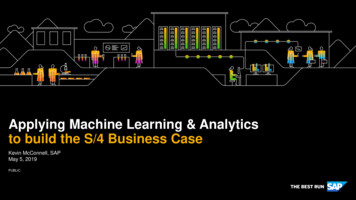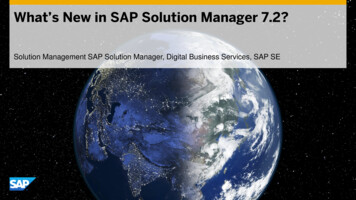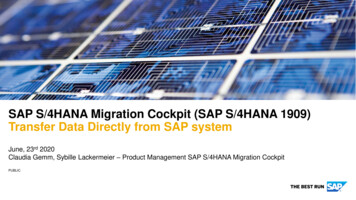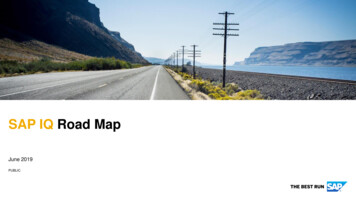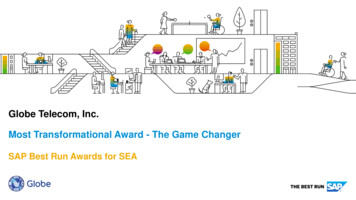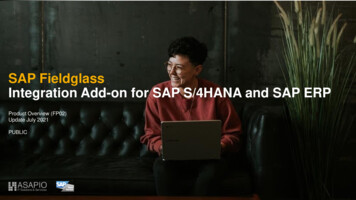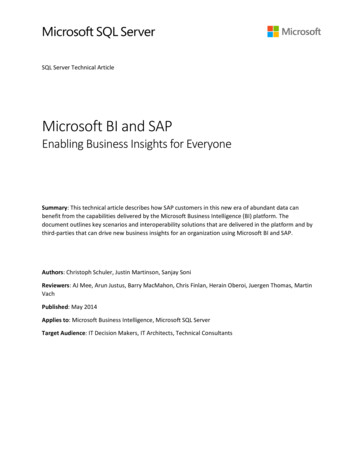
Transcription
SQL Server Technical ArticleMicrosoft BI and SAPEnabling Business Insights for EveryoneSummary: This technical article describes how SAP customers in this new era of abundant data canbenefit from the capabilities delivered by the Microsoft Business Intelligence (BI) platform. Thedocument outlines key scenarios and interoperability solutions that are delivered in the platform and bythird-parties that can drive new business insights for an organization using Microsoft BI and SAP.Authors: Christoph Schuler, Justin Martinson, Sanjay SoniReviewers: AJ Mee, Arun Justus, Barry MacMahon, Chris Finlan, Herain Oberoi, Juergen Thomas, MartinVachPublished: May 2014Applies to: Microsoft Business Intelligence, Microsoft SQL ServerTarget Audience: IT Decision Makers, IT Architects, Technical Consultants
CopyrightThis document is provided “as-is”. Information and views expressed in this document, including URL andother Internet Web site references, may change without notice. You bear the risk of using it.Some examples depicted herein are provided for illustration only and are fictitious. No real associationor connection is intended or should be inferred.This document does not provide you with any legal rights to any intellectual property in any Microsoftproduct. You may copy and use this document for your internal, reference purposes. 2014 Microsoft. All rights reserved.2
Table of ContentsCopyright . 2Executive Summary. 4Microsoft BI and SAP. 5Any data, any size, anywhere . 5Connecting with the world’s data . 5Immersive data experiences . 5Microsoft BI Scenarios for SAP. 7Power Query Connectivity to SAP BusinessObjects BI Universes . 8SAP NetWeaver Gateway. 10Theobald Software - Xtract PPV . 11SAP ODBO Connector for SAP BW (on HANA or non-HANA platform) . 12Microsoft Connector for SAP BI . 13Data Provider for SAP (part of Microsoft BizTalk Adapter Pack) . 14Theobald Software - Xtract IS . 15ODBC Provider for SAP HANA . 16Simplement Data Liberator . 17.NET Data Provider and Query Designer for SAP NetWeaver BI. 18Theobald Software - Xtract RS . 19Conclusion . 20For more information . 203
Executive SummaryThe world of data is changing. We are seeing the convergence of a number of significant trends that arefundamentally transforming the industry. The first trend is data growing at exponential rates, in moretypes, shapes and sizes than ever before. The drivers for this data growth range from increasedtransactional processing in businesses to billions of users interacting on social media using connecteddevices to billions of signals generated by machine-to-machine interactions every day. The second trendis a change in the way users are consuming and collaborating on data. Users have new expectations onhow to collaborate effectively around information and ideas. The third trend is driven by cloudeconomics that enable companies to do things they could not do before. The cost of storage, computeand networking continues to decline, enabling new scenarios where the perceived value of ambient datais greater than the cost of storing it, processing it and analyzing it for insights.In this changing world, organizations are struggling to keep up with increasing amounts of data, bothstructured and unstructured, and the inability and cost of IT to keep up with user demands. Businessesare faced with new questions like ‘How effective is my online campaign?’, ‘How do I optimize my truckfleet based on weather patterns?’, or How do I predict future results?’. Data stored in SAP systemsplays a critical role in answering these types of business questions. However, these new types ofquestions cannot be answered without tapping into the vast amounts of data that is available.Organizations that are able to take advantage of new technologies to ask and answer these new types ofquestions will be able to more effectively differentiate and derive new value for the business whether itis in the form of revenue growth, cost savings or creating entirely new business models.Microsoft envisions a world where every organization is moving towards a data-centric culture. A “dataculture” develops when, with the right tools, insights can come from anyone, anywhere, at any time. Ina data culture, the entire effectiveness of an organization can elevate. This is especially true when everyemployee can harness the power of data once only reserved for data experts or IT and take advantageof the power of self-service business insights, visualization capabilities and natural language that workinside familiar tools. Microsoft’s data platform, built across Office 365, SQL Server and Azure, is aimed atenabling this data culture.4
Microsoft BI and SAPEnabling a data culture where everyone in an organization is empowered to derive new business insightsis at the core of Microsoft BI solutions.Any data, any size, anywhereMicrosoft BI solutions provide data management and access to all data types, acrossstructured and unstructured data sources. Structured data includes businessinformation from SAP systems about customers, products, assets, manufacturingprocesses, or employees that is critical in gaining valuable business insights.When combined with other data sources, for example external data from a marketplace,or unstructured data from Hadoop, the power to derive new business insights isamplified and can uncover new opportunities for the business.For IT organizations, this presents several challenges. Data in SAP systems is not easily ordirectly accessible and contained in various formats, transactional or aggregated, spreadacross different locations and database systems. Transactional data volumes are steadilyincreasing and the user demand for up-to-date business insights is growing.Connecting with the world’s dataMicrosoft BI solutions enable data enrichment by connecting to the world’s data through a globalmarketplace for curated data and services authored by Microsoft and 3rd parties. Using familiar tools inExcel, you can discover and combine data, enriching your organization’s data with information such associal analytics or with 3rd party data sets. Imagine a retail business that is competing on price for theproducts they offer. By utilizing pricing information from social channels or marketplaces aboutneighboring stores and competing markets, and comparing this information with profit margins andsales data from their SAP system, the retailer is able to lower prices when and where necessary and forthe right products.Immersive data experiencesWith Power BI for Office 365, Microsoft is offering a complete self-service BI solution delivered throughExcel and Office 365 that provides data discovery, analysis, and visualization capabilities to identifydeeper business insights from data. The Power BI for Office 365 service is a cloud-based solution thatenables collaboration and reduces the barriers to deploying a BI environment for sharing reports andaccessing information. Customers can also realize these benefits in their on-premise environment usingSQL Server, SharePoint and Excel. Included in Power BI are:Power Query - For data search and discovery. A data search engine allows customers toquery data from within their business and from external data sources on the Web, allwithin Excel. Power Query also cleans and merges data sets from multiple sources,enabling IT and BI users to focus on data insights rather than data management.Power Pivot - For analyzing and modeling data. Power Pivot enables customers tocreate flexible models within Excel that can process large data sets very quickly usingSQL Server’s in-memory database technology. Users can customize the model as neededall within Excel – no extra development needed.5
Power View and Power Map - For visualizing and exploring. Using Power View,customers can manipulate data and turn it into charts, graphs, and other visual meanswhich work great for presentations and reports.Power Map is a 3D data visualization tool for mapping, exploring and interacting withgeographic and temporal data.Data and insights exposed using these capabilities in Excel are also available in the cloud through PowerBI for Office 365. Customers can share and access their BI models and reports across the desktop, Weband devices, within a trusted, managed environment.Within their organization’s trusted environment, BI users can quickly create BI Sites inOffice 365 to share worksheets with colleagues, collaborate over insights and results,and quickly find data and reports. Data in reports published to Office 365 can berefreshed from on-premised data sources through the Data Management Gateway. Thisensures that the data in your workbooks is current.With Q&A, Power BI sites provide an innovative new natural language query capabilitythat allows users to type a question into a dialog box. The system understands thesemantics of the question being asked and instantly generates an answer using chartsand graphs of the correct data for the user.To enable users to stay connected to their data wherever they are, Power BI provides aconnected experience. BI users can access and receive live updates on their reportsthrough their browser with HTML5 or through a mobile application designed for theirdevice.6
Microsoft BI Scenarios for SAPThe following pages will provide you with an overview of different scenarios that are available forcustomers today to bring SAP data into their Microsoft BI solutions and by doing so, create new businessinsights for anyone in their organization.End users can directly connect to SAP to discover business data using Power Query forExcel. SAP data and metadata is made available through the semantic layer (Universe) inSAP BusinessObjects BI. SAP data can be loaded directly into a worksheet or a PowerPivot model. From there, the end user can combine, analyze, visualize and sharebusiness data using Power BI.End users can directly connect to SAP to analyze data, using Power Pivot or PivotTablesin Excel. SAP data and metadata is made available through connectors from third-partiesand SAP. With Power Pivot, SAP data can be loaded directly into a data model and userscan combine, analyze, visualize and share business data and insights using Power BI.Further, a user can analyze SAP data using PivotTables or PivotCharts.In a data warehouse scenario corporate IT can use SQL Server Integration Services (SSIS)to extract, transform and load data into a SQL Server database. SAP data and metadatais accessible through Microsoft and third-party connectors. With SAP data stored in adata warehouse, the full stack of Microsoft BI tools for IT and end users becomesavailable to further enrich, combine, analyze, visualize and share the data.In the more traditional scenario of operational reporting, corporate IT can use SQLServer Reporting Services (SSRS) to directly connect to data in SAP. SAP data andmetadata is accessible through Microsoft and third-party connectors. Reports can berefreshed and shared with other users through the built-in SharePoint integration.Each of the scenarios and connectivity solutions that are described will map to the Discover, Analyze,Integrate, and Report categories from above. As you evaluate the different solutions, considerimportant factors such as the location and type of your SAP data. Is your SAP data only available in thetransactional ERP system? Or is it available in the form of BW cubes or BusinessObjects BI Universes?Also consider the required release and support level for each of the scenarios listed, both for theMicrosoft BI tools as well as your SAP environment.7
Power Query Connectivity to SAP BusinessObjects BI UniversesUsing Power Query, the Excel user can discover and analyze SAP data by connecting directly to SAPBusinessObjects BI Universes. This connectivity provides metadata and data from dimensional,sometimes called common, semantic layer Universes which have a UNX file extension. This solution wasjointly developed by Microsoft and SAP.Key advantages: Excel users have seamless and direct access to SAP data exposed via SAP BusinessObjects BIUniverses Excel is a familiar front-end tool, no need to learn complex new tool set or skills Semantic layer of SAP BusinessObjects BI Universes hides the complexity of the underlying SAPdata source Customers can leverages existing investments in Microsoft and SAP BI technologies SAP data can be loaded into Excel table or Power Pivot data modelSAP BusinessObjects BI Universe in Power Query Navigator8
SAP BusinessObjects BI Universe in Query EditorSAP BusinessObjects BI Universe in Power Pivot Data ModelRequirements: Excel 2010 Professional Plus with Software Assurance or Excel 2013 Professional Plus, Office 365ProPlus, or Excel 2013 Standalone Power Query for Excel SAP BusinessObjects BI 4.1 SP2 or higherFurther details and download: Power BI Connectivity to SAP BusinessObjects BI: http://www.microsoft.com/en-us/powerBI/SAP.aspx Power BI Connectivity to SAP BusinessObjects BI ?LinkId 3991149
SAP NetWeaver GatewaySAP NetWeaver Gateway is a newer technology from SAP, originally designed to facilitate access to SAPdata for people-centric mobile and web applications. SAP NetWeaver Gateway is based on openstandards and uses the OData protocol to enable access to business data. OData can be easily consumedby various client applications, including Excel with Power Query and Power Pivot in BI scenarios.SAP NetWeaver Gateway provides access to these SAP data sources: SAP ERP: BAPIs/remote function modules, ABAP objects, WebDynproSAP BW: BW queryKey advantages: Enables standard OData access to SAP business data Supports other use cases, e.g. R/W integration with SharePoint, Office, mobile apps Works with SAP ERP, SAP CRM, SAP BW, SAP HANARequirements: SAP NetWeaver Gateway Excel 2010 or Excel 2013SAP Data in Power Query using OData FeedFurther details and download: SAP NetWeaver Gateway on SCN: http://scn.sap.com/community/netweaver-gateway SAP NetWeaver Gateway Demo System: http://scn.sap.com/docs/DOC-3122110
Theobald Software - Xtract PPVIn this solution, Power Pivot uses Xtract PPV as a data source which can extract data from an SAPsystem. Xtract PPV has a server component, which extracts data from SAP ERP or SAP BW and providesit as an OData feed to Power Pivot. Xtract PPV has a designer tool which is used to define the dataextracts.Theobald products are licensed separately. Xtract PPV provides access to these SAP data sources: SAP ERP: tables, queries, BAPIs/remote function modules, ABAP reports, DeltaQ SAP BW: cubes and queries, hierarchies, Open Hub Service, DeltaQKey advantages: Direct access to virtually any SAP data object. Not limited to SAP BW. SSO enabled via SNC (Secure Network Communication) SAP data exposed as ATOM data feed, making it suitable for other applicationsRequirements: SAP ERP: release 4.0B and above, 4.6A and above for DeltaQ extraction SAP BW: release 3.1 and above, 3.5 and above for Open Hub Services extractionXtract PPV Designer with supported SAP sourcesFurther details and download: Theobald Xtract PPV: tppv.htm Microsoft Power Pivot: http://www.microsoft.com/powerbi11
SAP ODBO Connector for SAP BW (on HANA or non-HANA platform)In this solution, you can connect an Excel PivotTable directly to an SAP BW system via the SAP ODBOProvider. The Excel user can select from available cubes and queries in SAP BW and work with SAP datain PivotTable reports or PivotCharts. The OLE DB provider requires username/password authentication.For SAP HANA based systems, an ODBC driver is available which can be used to connect Excel to the SAPHANA database, and using SQL statements query the data. The recommended approach by SAP is to usethe ODBO (MDX) connector, because it takes advantage of the metadata in the HANA repository. Incomparison, the ODBC driver will connect directly at the database level and surface database objects.The ODBO Provider enables access to these SAP data sources: SAP BW: cubes and queriesKey advantages: Enables direct consumption of SAP BW cubes and queries in ExcelRequirements: Excel 2007, Excel 2010 or Excel 2013 OLEDB for OLAP Provider, available from SAP MarketplacePivotTable using ODBO Provider for SAP BWFurther details and download: SAP OLE DB for OLAP:http://help.sap.com/saphelp /content.htm Connecting SAP HANA with 4ed57e62?quicklink index&overridelayout true12
Microsoft Connector for SAP BIThe Microsoft Connector for SAP BI enables you to extract data from, or load data into, an SAP BWsystem. The connector is intended for use with SSIS and includes three main components: SAP BI DataSource, SAP BI Destination and SAP BI Connection Manager. Data extraction via Open Hub Services(OHS) requires a separate SAP license. OHS provides three options to unload data: (1) directly to anexternal system (SSIS), (2) into tables in SAP BW and (3) into flat files. Some customers prefer to useoption (2) with a subsequent table extract to optimize for performance. The Data Provider requiresusername/password authentication.The Microsoft Connector for SAP BI provides access to these SAP data sources: SAP BW: cubes (info providers)Key advantages: SAP certified integration scenario Supports delta extraction and packaging; well suited for large amounts of data Supports parallel extractionRequirements: SAP BW: release 7.0 SPS 17 or above; Open Hub Services license and configuration Works with SQL Server Integration ServicesMicrosoft Connector for SAP BI in SQL Server Integration Services projectFurther details and download: Microsoft Connector for SAP 8(v sql.120).aspx The Connector is available as part of the SQL Server Feature Pack13
Data Provider for SAP (part of Microsoft BizTalk Adapter Pack)With the Data Provider for SAP you can read data from an SAP table/view or a remote-enabled functionmodule/BAPI. Supported SAP table types include transparent, pool and cluster tables.The Data Provider requires a custom function module to be installed on the SAP system. With thefunction module, SAP data is extracted from tables or views, type converted and returned to the SSISpackage. The function module has built-in functionality to optimize for large data extractions and returnthe data in multiple packages. The Data Provider requires username/password authentication.The Data Provider for SAP enables access to these SAP data sources: SAP ERP: tables, BAPIs/remote function modules SAP BW: tables, BAPIs/remote function modulesKey advantages: Well-suited for table extraction Good performance for larger data sets Supports parallel extraction Standardized ADO.NET interface for use with other client appsRequirements: Custom function module (shipped with Data Provider) installed on SAP system Microsoft Adapter Framework Works with SQL Server Integration ServicesFurther details and download: .NET Data Provider with SSIS: http://msdn.microsoft.com/en-us/library/cc185548(v bts.10).aspx BizTalk Server LOB Adapter Pack: ormation/line-ofbusiness-adapter-pack.aspx14
Theobald Software - Xtract ISThe Theobald Xtract IS product suite enables SQL Server Integration Services to extract data fromvirtually any SAP data object in an SAP business system (ERP, CRM, SCM, etc ) or SAP BW system.Theobald products are licensed separately. The Xtract IS suite offers nine components for these SAPdata sources: SAP ERP: table, query, BAPI/remote function module, ABAP report, DeltaQ SAP BW: cube/query, hierarchy, Open Hub Services, BW loader, DeltaQKey advantages: Access to virtually any SAP data object SSO enabled via SNC (Secure Network Communication) Easy to install and use. Search/browse for data objects in SAP by descriptionTheobald XtractIS in SQL Server Integration ServicesRequirements: SAP ERP: release 4.0B and above, 4.6A and above for DeltaQ extraction SAP BW: release 3.1 and above, 3.5 and above for Open Hub Services extraction Works with SQL Server Integration ServicesFurther details and download: Theobald Xtract IS: tis.htm15
ODBC Provider for SAP HANASAP HANA has a supported ODBC interface which provides database access for third-party tools. UsingSQL Server Integration Services, data can be extracted from an SAP HANA database, transformed andloaded into a SQL Server Data Warehouse.The ODBC Provider for SAP HANA provides access to these SAP data sources: SAP ERP on SAP HANA: tables SAP BW on SAP HANA: tablesKey advantages: Works with any SAP system on top of SAP HANA (ERP, BW, CRM )Requirements: SAP HANA ODBC driver Works with SQL Server Integration ServicesFurther details and download: Third Party ETL for SAP HANA: -sap-hana16
Simplement Data Liberator As an alternative to the ETL methods described previously, the Simplement Data Liberator builds uponthe same replication technology used for hot standby purposes. Using this technology, data can bereplicated continuously from the underlying database of the SAP system into a SQL Server database.Simplement products are licensed separately. Simplement Data Liberator provides access to these SAPdata sources: SAP ERP: database tablesKey advantages: Once initialized, data streams continuously in real-time Well suited for large volumes of reporting data Security context and hierarchies are replicated with dataRequirements: Configuration of database replicationSimplement Data Liberator Replication ManagerFurther details and download: Simplement Data Liberator: http://www.simplement.us/dataliberator.shtml17
.NET Data Provider and Query Designer for SAP NetWeaver BIFor operational reporting scenarios, SQL Server Reporting Services provides built-in connectivity to anSAP BW system. Report design and execution is supported with a .NET data provider and query designerthat connects directly to the XML/A interface of an SAP BW system. SSO is supported via SAP logontickets.The .NET Data Provider for SAP NetWeaver BI provides access to these SAP data sources: SAP BW: cubes and queriesKey advantages: Enables direct reporting against SAP BW Delivered with SQL Server Reporting Services (no separate install) SSO is supported via SAP logon tickets (requires ticket issuing system)Requirements: Works with SQL Server Reporting Services SAP BW 3.5 SP20, or SAP BW 7.0 SP10. For SAP BW releases 7.3 and 7.4 there is a knownconnection issue that is under review.SQL Server Reporting Services Query Designer with SAP BWFurther details and download: SQL Server Reporting Services with SAP NetWeaver BI: http://msdn.microsoft.com/enus/library/cc974473(v sql.100).aspx18
Theobald Software - Xtract RSTheobald Xtract RS enables SQL Server Reporting Services (SSRS) to access data from virtually any SAPdata object in an SAP business system or SAP BW system.Theobald products are licensed separately. Xtract RS provides read access to these SAP data sources: SAP ERP: table, query, BAPI/remote function module, ABAP report SAP BW: cube/queryKey advantages: Direct reporting access to virtually any SAP data object. Not limited to SAP BW. SSO enabled via SNC (Secure Network Communication) Easy to install and use. Tight integration into SSRS design tools. User can search/browse for dataobjects in SAP by descriptionRequirements: SAP ERP: release 4.0B and above SAP BW: release 3.1 and above Works with SQL Server Reporting ServicesFurther details and download: Theobald Xtract RS: trs.htm19
ConclusionIn this new era of abundant data, Microsoft is uniquely positioned to offer organizations the tools andplatform they need to harness the power of data and make it easy for all users to achieve new businessinsights. Through the tools outlined in this paper, individuals and organizations are able to tap into thevalue of business data in an SAP system, and use familiar tools to combine, enrich and share insightsthat was previously not possible.For more information Microsoft BI: http://www.microsoft.com/biMicrosoft Power BI: http://powerbi.comSQL Server: http://www.microsoft.com/sqlserverMicrosoft and SAP: http://www.microsoft.com/sapDid this paper help you? Please give us your feedback. Tell us on a scale of 1 (poor) to 5 (excellent), howwould you rate this paper and why have you given it this rating? For example: Are you rating it high because it has good examples, excellent screen shots, clear writing, oranother reason? Are you rating it low because of poor examples, fuzzy screen shots, or unclear writing?This feedback will help us improve the quality of the white papers we release.Send feedback.20
Microsoft BI tools as well as your SAP environment. 8 Power Query Connectivity to SAP BusinessObjects BI Universes Using Power Query, the Excel user can discover and analyze SAP data by connecting directly to SAP BusinessObjects BI Universes. This connectivity provides metadata and data from dimensional,



